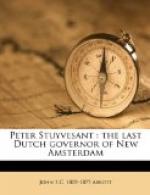At four o’clock in the afternoon of the 26th of July, this little band commenced its march through the trails of the wilderness, towards the setting sun. The path was a rugged one over high hills and across mountain streams. They had traversed but a few miles when night came on and they bivouacked until daybreak. The next morning they pressed forward with all vigor until they were within about six miles of the fort. One hundred and sixteen men were then sent forward to attack the Indians by surprise, while the remainder prudently followed close after as a reserve.
But the wary Indians, through their scouts, had ascertained the approach of the foe and had fled with their prisoners to the mountains. The Dutch were astonished at the strength of the fort and at the scientific skill with which it was constructed. The Indians had evidently learned not a little of military art from the Europeans. Three parallel rows of palisades enclosed a large square, with loopholes through which unobstructed aim could be taken at assailants. Within the palisades there were strong block-houses, provided also with loopholes, to which houses the warriors could retreat, as to citadels, in case the outer works were taken. Between the houses and the outworks there was a creek. The whole fortress would have been no disgrace to an European engineer.
The party found very comfortable quarters in the fort for the night, and an ample supply of provisions. An Indian woman, not being aware that the white men were in the fort, came back for some article she had left behind. She was taken prisoner and informed her captors of the direction in which the Indians had fled. As it is necessary for such a party of two or three hundred, to keep together and as the trail through meadows, across streamlets and over mountains is narrow, it is not difficult having once found their track to follow it.
It was determined, after a brief consultation, to pursue them. The next morning at daybreak, the pursuit was commenced. Twenty-five men were left to keep possession of the fort. After several hours of very fatiguing travel, they reached the spot, on a high mountain, where the squaw supposed that the Indians had established their camp. But not an Indian was there. They had probably left their spies on the path, who had informed them that the foe was at hand.
The woman now said that they must have gone on to another stronghold they had, at the distance of about six miles. The march was continued through great difficulties. But it was fruitless. Not an Indian was to be found. They had another stronghold about twelve miles farther on. It was possible that they might be found there. But all were fatigued and discouraged, and were disposed to give up the hopeless chase. At one time they caught sight of nine savages in the distance, but they fled like deer.




